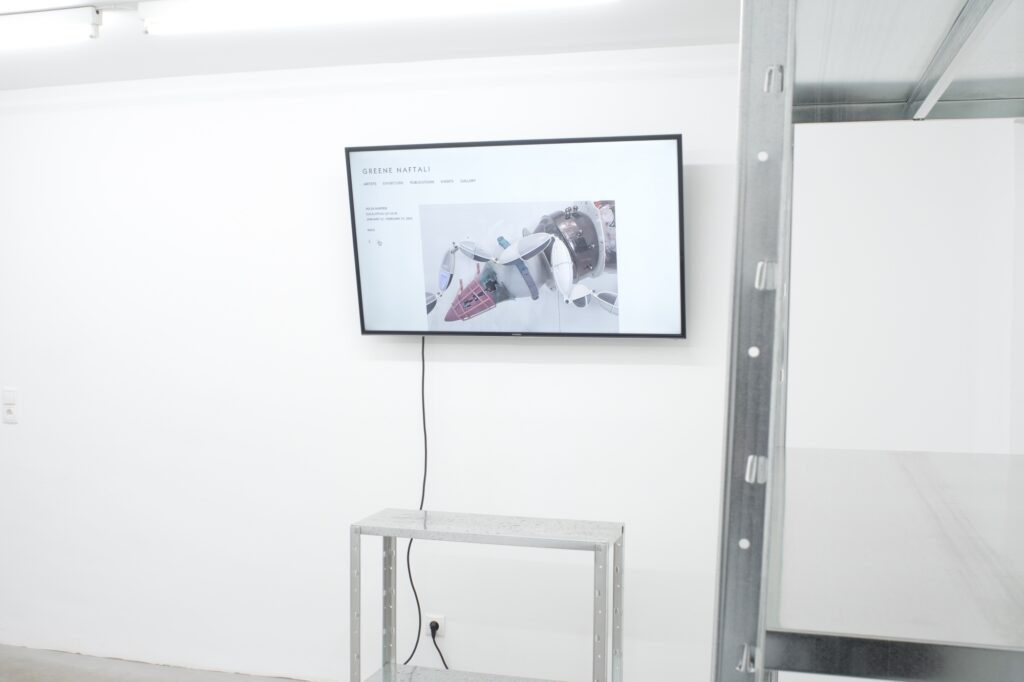The material is the medium – is the message – equals questionable content – or is there any content left?
Patrick Fabian Panetta’s (b. 1977, lives and works in Berlin) video works at his MÉLANGE show belong to the same series but are displayed in variety of common modes of video-art-presentation: A massive flat screen in the front room, stacked Hantarex cube monitors in the back and an old-fashioned TV from a 90’s hotel room in the office area.
The shown material is an appropriation of screen recorder visits of well-known gallery websites with randomized sound in the background. We follow the user clicking through anything he can find, presenting us the “latest trends” in the art world. The choices of websites to visit is based on the scale of rating, which is determined through algorithmic rankings based on probability of importance. The websites’ designs become almost cinematic, while the actual content – information on artists’ works, gallery, and more – becomes a blown up spectacle. These programmed “pieces” create a spectacle, that should be a basic tool for information, tend to reduce its content to superficiality, while excitement is strictly limited to coded effects. The actual idea of works of art is not the subject of consumption anymore, it is in fact the “Informationsapparat” (information device) itself. Design, shine, glamour, and standardized forms press everything into a representative surface for a power play inside the art market. The content of these websites are focusing the viewer’s perception processes not on the works of art, but on a hyper-visuality where they experience a flattened dimension suited and limited by the screen. The hyper-visuality does not communicate qualities of individual works, artist intentions or problems, but sells an all over synchronized perception of a need of visual satisfaction. A gallery’s website in today’s art market is equal to the old fashioned idea of the “Präsentationsapparat” [Hans Zitko: Kunstwelt. Mediale und systemische Konstellationen, Fundus, Frankfurt 2012.] in the art world, an idea which has been extensively discussed in the 1990s through institutional critique. The virtual space has generated the same issues that the physical space – museum or gallery – has for the past decades. At the center of this conflict is the impossibility of justification or authentication of “good” art. These spaces – virtual and physical – construct an amplified visual experience, not necessarily the intention of the artworks existence as dispute with its producers problems.
By the act of reputation Panetta accumulated a dense collection of material. This material or way of working begs the question of authenticity, authorship and of production. The works are not really produced, and are a denial of the idea on an artistic production – even a resignation that there is nothing new that can be produced. Panetta’s use of “Informationsapparate”, which at the beginning feels like an appropriation of art, are nothing more than a homage to the impossibility of a constant reinvention of art itself spiced with an ambient sound. In sum, it suggests the viewer as part of a personal entanglement with the subject on the screen. But it never becomes a choreography – and is not as calculated as it could be. The modes of display only cite common formulas of presenting a video, thus showing their co-dependence on technical development.
Patrick Fabian Panetta Scale of Rating
Mélange 02/02/2016—06/03/2016

Patrick Fabian Panetta: SCALE OF RATING / A FINAL CUT, 2016, Screen capture, sound, min. 20:15, installation view, MÉLANGE 2016

Patrick Fabian Panetta: SCALE OF RATING / A FINAL CUT, 2016, Screen capture, sound, min. 20:15, installation view, MÉLANGE 2016

Patrick Fabian Panetta: SCALE OF RATING / A FINAL CUT, 2016, Screen capture, sound, min. 20:15, installation view, MÉLANGE 2016

Patrick Fabian Panetta: SCALE OF RATING / A FINAL CUT, 2016, Screen capture, sound, min. 20:15, installation view, MÉLANGE 2016

Patrick Fabian Panetta: SCALE OF RATING / A FINAL CUT, 2016, Screen capture, sound, min. 20:15, installation view, MÉLANGE 2016

Patrick Fabian Panetta: SCALE OF RATING / A FINAL CUT, 2016, Screen capture, sound, min. 20:15, installation view, MÉLANGE 2016

Patrick Fabian Panetta: SCALE OF RATING / A FINAL CUT, 2016, Screen capture, sound, min. 20:15, installation view, MÉLANGE 2016

Patrick Fabian Panetta: SCALE OF RATING / A FINAL CUT, 2016, Screen capture, sound, min. 20:15, installation view, MÉLANGE 2016

Patrick Fabian Panetta: SCALE OF RATING / A FINAL CUT, 2016, Screen capture, sound, min. 20:15, installation view, MÉLANGE 2016

Patrick Fabian Panetta: SCALE OF RATING / A FINAL CUT, 2016, Screen capture, sound, min. 20:15, installation view, MÉLANGE 2016